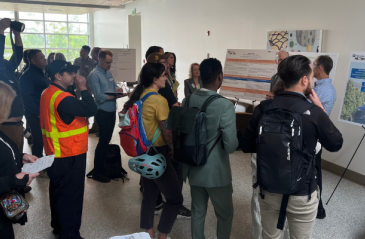
The information barriers holding back climate action and how to break them

Promise Tracker explores how community monitoring hold elected leaders to account
Share articleUsers can define issues and develop surveys to distribute to community members’ phones
Share articlePromise Tracker helps communities collect information that helps government accountability
Share articleWe put our vision for government into practice through learning partner projects that align with our values and help reimagine government so that it works for everyone.
On a sweltering day in late August 2015, a group of residents from Brazil's northern city of Belém do Pará gathered in the centre of the city's most famous and bustling outdoor market, Ver-o-Peso. With smartphones in hand, the team walked up and down aisles filled with fruit, nuts, dried fish and clothing, snapping photos, geo-tagging stalls and recording the presence of trash in the walkways.
Among the group were lifelong residents of the neighbourhood, members of the Social Observatory of Belém (a local NGO), representatives from City Hall's Department of Solid Waste, and employees of one of the biggest sanitation companies in the state. The information gathered that afternoon was the first collaborative community dataset collected with Promise Tracker, a new project from MIT's Center for Civic Media. It explores the role that community monitoring can play in holding elected leaders to account for promises they make about infrastructure.
This data will help monitor one of several multimillion dollar clean-up contracts paid for by the city every year. Several months before, irregularities in the size and negotiation of sanitation bids began to get coverage in the local press, and the Social Observatory was eager to channel residents' frustration into some productive way of addressing the issue. This outrage over bloated budgets and government inefficiencies is by no means unique to Belém or to the developing world, and it leaves millions of communities wondering what they can do to increase accountability and improve quality of life in their cities.
At MIT's Center for Civic Media, we study how new technology tools transform the way we see our role as communities and offer new avenues for how we participate in civic life. Over the past two years, we've been developing and piloting Promise Tracker to explore infrastructure monitoring as a mechanism for increasing the accountability of elected leaders and engaging communities outside of the election cycle.
Promise Tracker provides communities with a platform to collaboratively assess local infrastructure and track commitments made by elected leaders. Using a simple web application, users can define issues or promises they see as priorities and develop surveys to distribute to community members' phones. Using this survey, residents can submit photos, locations and other information via a mobile app and visualise the aggregated responses in online maps and graphs.
Belém is one of nine cities where we have developed and tested the platform over the past year. We have used it to monitor issues from trash collection and maintenance of public parks to the accessibility of bus stops for the disabled and the quality of wi-fi hotspots. Partnering with civil society groups in the city, we worked with 15-20 people including community organisers, architects, university students and civil servants to create a data-based snapshot of the issues they felt were of greatest concern.
In city after city, we confirmed something that was clear from the project's inception - more valuable than the monitoring platform itself was the civic process it inspired. In order to launch a data collection campaign, groups needed to come to an agreement on priorities and break down complex local issues into indicators they could track. Through data collection, they developed an intimate understanding of the terrain of the city and how and where the problems they were tracking appeared. Once information was gathered, participants had to work together to analyse the data and strategise who they needed to present it to in order to address the issue.
As one of the founders of the Social Observatory of Belém noted: “with the host of problems we face today, there is a tendency towards either apathy and disengagement or complaining. Through collaborative monitoring we're forced to get out of the mindset of merely reporting individual incidents and begin thinking about how we can work together towards solutions. If you're going to make an ask of government, you need to know what you're asking for and have actionable information to direct the response.”
Cases like Belém offer a monitoring model that can seen be seen as a win-win for government and communities. A cleaner and more orderly market means a better experience for regular shoppers and merchants and a more positive portrait of the historic city for tourists. As private companies were being hired to provide sanitation services, an exposé of below par performance would not be a direct attack on City Hall but rather an additional resource to support the renegotiation and enforcement of contracts.
In the end, the exercise of bringing together all the actors (public, private and communities) to agree on reasonable indicators and participate in the assessment proved to local government that this type of monitoring could benefit a range of other services. It could help City Hall stay in front of issues they might not have had the manpower to assess actively.
One of our main objectives in developing Promise Tracker was to empower communities to collect information that contributes to greater transparency and government accountability. Though discussions about monitoring often focus on local government's responsibilities to its communities, we are interested in tools like this one that offer new avenues for delivering on our responsibilities as communities. Monitoring local infrastructure and services is one way to fulfil this role. It is also an opportunity to spark discussions on both sides of the divide about what more proactive and collaborative development could look like.
Over the next months we'll be incorporating feedback from users in Belém and other pilot cities into a version of Promise Tracker that we plan to release to a wider audience.
Data to delivery. Baltimore's recent unrest made headlines around the world. But the city had previously been seen as a model for good governance and delivery - much of which was pioneered by its former mayor, Martin O'Malley. He tells us about a new way of governing
Open all hours. Liz Carolan explains how open data can help accelerate development progress around the world
Moving beyond open data. Adrian Brown says governments should take a strategic approach to open data
Data deliverers. International policymakers set out their priorities as they promote open data in their governments
A doorway to delivery. Kevin Donahue has spent his career seeking to harness the power of data to improve government services. He tells Adrian Brown why good data is not an end in itself, but rather an opportunity to achieve better community outcomes











